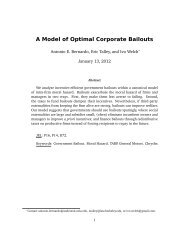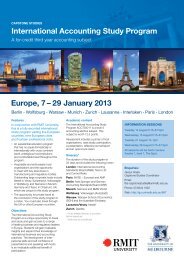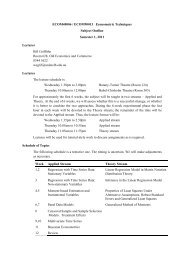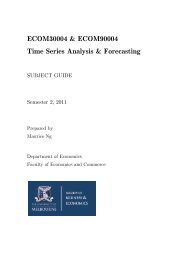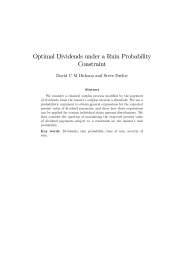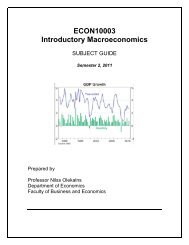Bayesian Inference in the Seemingly Unrelated Regressions Model
Bayesian Inference in the Seemingly Unrelated Regressions Model
Bayesian Inference in the Seemingly Unrelated Regressions Model
Create successful ePaper yourself
Turn your PDF publications into a flip-book with our unique Google optimized e-Paper software.
22<br />
The conditional posterior pdf for ( Σ | y)<br />
is <strong>the</strong> same <strong>in</strong>verted-Wishart distribution as<br />
was given <strong>in</strong> equation (20). The marg<strong>in</strong>al posterior pdf for β is<br />
−T<br />
2<br />
f( β | y) ∝ A I S ( β )<br />
(45)<br />
The posterior pdf for β 1 conditional on <strong>the</strong> rema<strong>in</strong><strong>in</strong>g β i is <strong>the</strong> truncated multivariate<br />
t-distribution<br />
− ( K + v )/2<br />
1 1<br />
⎡ ( β1−β# 1) ′ X ′<br />
1 Q(1) X1( β1−β#<br />
1)<br />
⎤<br />
f( β1| y, β2, β3,..., βM) ∝ ⎢v ⎥<br />
1+ I ( )<br />
2<br />
S β<br />
⎢<br />
s#<br />
1<br />
⎥<br />
⎣<br />
⎦<br />
(46)<br />
Of <strong>in</strong>terest is how to best use <strong>the</strong>se pdfs to draw observations on β , and<br />
possibly Σ , from <strong>the</strong>ir respective posterior pdf’s. The conditional posterior pdf’s for<br />
( β | Σ ) and ( Σ | β ) can be used with<strong>in</strong> a Gibbs sampler provid<strong>in</strong>g <strong>the</strong> <strong>in</strong>equality<br />
restrictions are sufficiently mild for a simple acceptance-rejection algorithm to be<br />
practical when sampl<strong>in</strong>g from <strong>the</strong> truncated multivariate normal distribution. By a<br />
“simple acceptance–rejection algorithm”, we mean that a draw is made from a<br />
nontruncated multivariate normal distribution and, if it lies outside <strong>the</strong> feasible region,<br />
it is discarded and replaced by ano<strong>the</strong>r draw. This procedure will not be practical if<br />
<strong>the</strong> probability of obta<strong>in</strong><strong>in</strong>g a draw with<strong>in</strong> <strong>the</strong> feasible region is small, which will<br />
almost always be <strong>the</strong> case if <strong>the</strong> number of <strong>in</strong>equality restrictions is moderate to large.<br />
Thus, we are us<strong>in</strong>g <strong>the</strong> term “mild” <strong>in</strong>equality restrictions to describe a situation<br />
where <strong>the</strong> maximum number of draws necessary before a feasible draw is obta<strong>in</strong>ed is<br />
not excessive.<br />
If <strong>the</strong> <strong>in</strong>equality restrictions are not mild, <strong>the</strong>n a Metropolis-Hast<strong>in</strong>gs<br />
algorithm can be employed. In <strong>the</strong> steps we described <strong>in</strong> Section III, if a candidate



